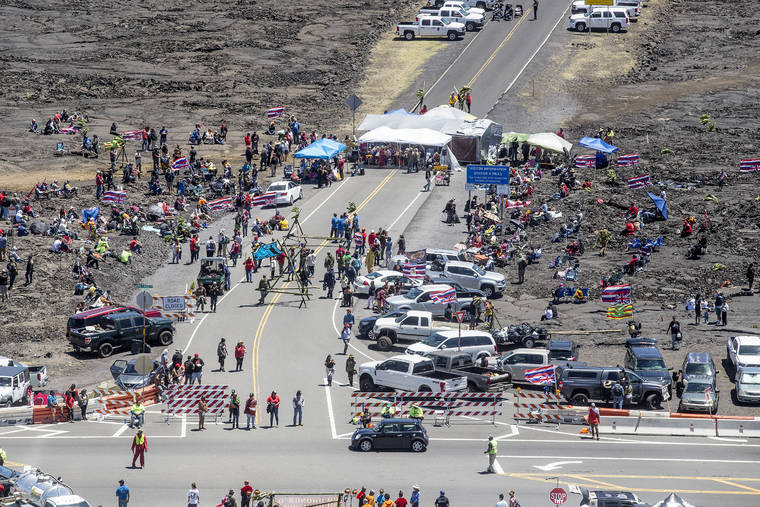HONOLULU — The man in charge of research and innovation at the University of Hawaii says there’s more at stake in the Thirty Meter Telescope impasse than the loss of an important astronomy outpost.
The university’s ability to attract research dollars could be seriously impaired, he says.
Vassilis Syrmos, UH vice president for research and innovation, said the loss of the TMT, should it come to that, could mean the loss of billions of dollars in research funding for the university over the next few decades.
The National Science Foundation is expected to decide its funding priorities for the next decade by the end of this year, and UH was expected to be positioned to receive billions for TMT-related astronomy research and instrumentation development, he said.
“If there’s no telescope, that funding goes somewhere else, ” Syrmos said.
The developers of the TMT rode a 10-year approval process to win the right to build the $1.4 billion project on Maunakea, one of three next-generation extremely large telescopes planned around the world.
But protesters, many of whom consider the summit of Hawaii’s tallest mountain sacred, have been camped at Maunakea Access Road for more than six weeks, blocking construction vehicles from reaching the construction site.
Syrmos said some fear that if the same anti-TMT forces were to thwart the renewal of UH’s astronomy lease for the Maunakea summit, not only would the world-class observatories on the mountain be imperiled, but UH’s Institute for Astronomy would be threatened.
The highly regarded Institute for Astronomy is among the top three programs at the university in terms of the amount of research dollars generated.
Overall, the university brought in $430 million in research money this year, a 10 % increase over the previous year. Syrmos said he’s working to move that number closer to a half-billion in the next three to four years.
But it may not be possible without the TMT.
“Right now our reputation is excellent, ” Syrmos said. “We’re going to be good enough in astronomy for years to come without the Thirty Meter Telescope. But we’re not going to be a center of excellence like we are now. We need to push the needle for our science and research. And the TMT is the opportunity.”
Syrmos said he’s also worried the failure to secure the TMT at Maunakea will affect research funding for other sciences, including the university’s top research-dollar generator, oceanography.
“How we’re going to be seen from the outside, I cannot predict. It is possible our reputation will be tarnished. How federal agencies look at us in making investments is to be seen, ” he said.
The larger programs are the ones most likely to be affected, he said. “When an agency is going start to put 30, 40, 50, 100 million dollars, they’re going to have to vet us extremely well nowadays.”
Rich Wacker, president and chief executive officer of American Savings Bank, said the loss of the TMT would put a huge dent in an ongoing effort to grow Hawaii’s research and innovation economy.
The instability and potential loss of the TMT is putting Hawaii at risk of not being able to demonstrate leadership in this potentially huge sector, he said.
“I think people understand it, but I worry that the sense of urgency to protect it is not as high as it should be, ” Wacker said.
Astronomy is a big part of the type of clean, well-paying endeavors that offer a lot of promise to Hawaii, the executive said.
“The future of the economy isn’t more federal government, the military or more tourism, ” he said. “We’ve got to find another growth area that will be compatible with maintaining the environment we want in Hawaii and compatible with the reality of Hawaii. We’re not going to be a manufacturing center. We’re not going to be an exporter of a lot of raw materials and goods.”
Hawaii already reaps nearly $500 million in research funding for UH and other federal programs.
“But it can be bigger, ” Wacker said, “And to attract the best kinds of research and funding, Hawaii has to compete against other universities and other communities that are fighting hard to be great at this.”
Take Salt Lake City, for example. It’s a place, he said, where science, research and innovation have exploded in the last five to 10 years.
“It’s really powerful, ” Wacker said. “We don’t have to be a Silicon Valley. There’s great examples throughout the country of communities like Utah, like the Carolinas, like Boston from way back, where the community has determined it can build excellence in this area. And that’s what we’re trying to do.”
The state, he said, has a basic social challenge of providing high-paying jobs and not relying on industries that can’t support higher wages.
“We’ve got to make that grow, ” he said of the cutting-edge research sector. “It’s important for the social fabric of the state. And it’s important for families who want kids to be able to come back and not have to go to the mainland to find jobs that pay enough to support families. That’s why we look at this area as one of the best opportunities to grow the economy in a way that helps ameliorate some of the challenges we have. If we choke it off, it just gets harder and harder.”
“We have enough hard things about doing business. We can’t keep creating more hurdles for the best areas of opportunity we’ve got, ” he said.
The biggest risk, he said, may be the inability to attract leading science and technology luminaries who will work with the business community to grow a strong innovation economy.
“That to me is the bigger issue, ” Syrmos added. “Are we going start losing our competitive edge and recruiting the best and brightest for astronomy because faculty go where the reputation is.”
Observation time is key, and UH will receive at least 7.5 % of the time on what will be one of the most sought-after telescopes on Earth.
“For one institution that’s huge. We’re talking about dozens of institutions competing for that time, and we have it blocked, ” Syrmos said.
Both Syrmos and Wacker said there has to be a compromise that will allow the project to go forward.
“I cannot accept it’s going to be one way or another, ” Syrmos said. “There’s got to be a way forward. My God, we live in the 21st century. We are all grown adults. We have to find a way forward.”
Wacker agreed.
“We can’t damage the future as the only price to solve these (protest) grievances, ” he said. “There’s got to be another way. There has to be a middle ground that can help address the real grievances but protecting this project that is so important to Hawaii’s future and so potentially damaging if it fails.”









